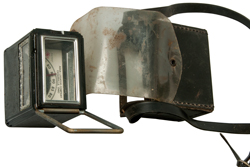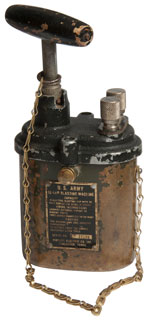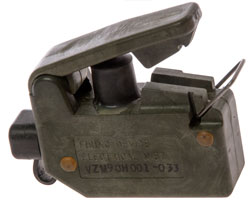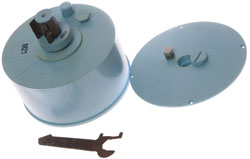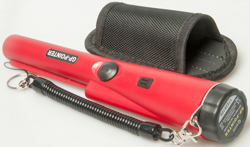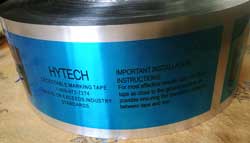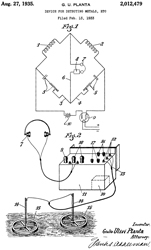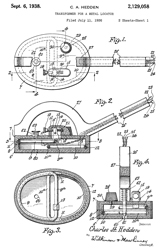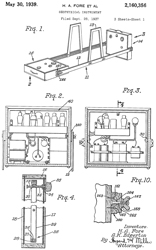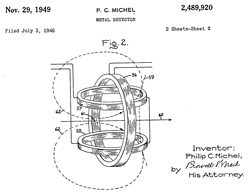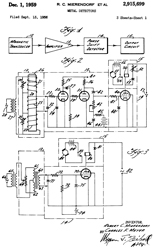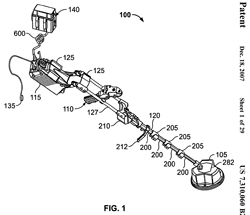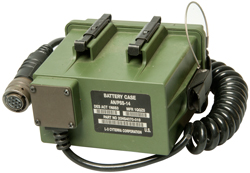Metal Locators
© Brooke Clarke 2021 - 2024
|
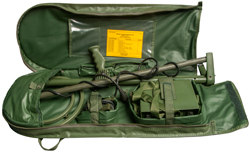 |
Description
Theory
Patents
Vendors
Kits
Related
References
Links
Background
A friend asked about metal detectors so started researching them. I have a number web pages related to mines. The original request was in relation to finding a water pipe in a backyard, so the page is named Metal Locators.
When U.S. president James A. Garfield was shot (Wiki) in 1881 there was no way to find the bullet and the germ theory of infection was not known (Wiki). While it did not work Alexander Graham Bell (Wiki) made an attempt to invent a metal detector for Garfield ("Forensics in the White House").
Book: Upon the Electrical Experiments to Determine the Location of the Bullet in the Body of the Late President Garfield -and upon- A successful form of Induction Balance for the Painless Detection of Metallic Masses in the Human Body. by Alexander Grahm Bell, Ph. D., Aug. 1882. (uponelectricalex00bell.pdf), 72 pgs. Most mine detectors/metal locators have their start from this book.
While most "metal locators" depend on either ferrous metal detection or detection of a conductive material, some depend on locating a magnet.
I have some related web pages:
Wiki page: Demining - is a broader topic than just detecting. (see the multiple Wiki "demining" web pages, most of which are related to post conflict mine fields.
Aqua Locator, Dip Needle or Miner's Compass
A magnetic compass with the pivot axis horizontal.
There's a half-silvered mirror at 45 degrees so that you can read the needle by looking horizontally or vertically.
Blasting Machines & Land Mines -
Newspaper article on Demining -
Polish Mine Detector -
PRS-7 Portable Mine Detecting Set Metallic and Non-metallic PSS-11 Mine Detecting Set - very very sensitive. metal eyelets in your shoes cause a lot of false alarms.
AN/PSS-12 Mine Detecting Set, Schiebel AN-19/2
GP-Pointer - One hand hold device. Made to find something while you are digging in a hole. Detects: Cu penny, Al foil, Quarter but not paper clip.
2021 Aug 16 - It does detect paper clip (1) power up while holding up in air & (2) back a couple of inches from tip (not sensitive at tip). This works better for body search than pinpointing (maybe it's just a repackaged body search wand?
The light is on in this photo.
Both the sounder and vibrator are also going.
Uses a 9V battery under black screw off cap.
This particular unit is either re-branded or a knock-off of the Garrett.
7575065 Metal detector with excavation tool, Robert J. Podhrasky, Garrett Electronics, 2009-08-18, -
9347798 Metal detector with hermetic housing, Gerald L. Johnson, Robert J. Podhrasky, Brent C. Weaver, Garrett Electronics, 2016-05-24, - "pinpointing metal detector,"
Ferrous Metal sensing
Aqua Locator Dip Needle or Miner's Compass - These are magnetic compass like devices where the needle axle is horizontal and the needle is reading the Earth's vertical magnetic field. Only works on ferrous metals, like iron water or gas pipes.
Flux Gate Magnetometers (Wiki) are a sensitive way to measure magnetic fields. I have a web page listing many FG patents. Many of these consume a very small amount of power since they were for use in naval mines. There's a large section of my Sensors web page about magnetic sensors.
Wiki: Metal Detector -
Non Ferrous Metal sensing
Many mine and metal detectors/locators will detect non ferrous metals. One of the main drivers is for gold detectors, but detecting aluminum is very important for locating underground plastic pipe when a "detectable warning tape" has been buried above the pipe.
Detectable Marking Tape (Wiki)
This one is colored blue for potable water.
It is not attracted to a magnet. But does contain aluminum foil.
Comes in a 1,000 foot roll.
"IMPORTANT INSTALLATION INSTRUCTIONS:
For most effective results bury HYTECH tape as close to the ground surface as possible enduring the maximum distance between tape and line."
This makes sense since there's two ways the tape helps:
- the Aluminum foil can be sensed by metal detectors (easier to detect the shorter the distance)
- the shiny tape can be seen by a backhoe operator (if tape contacting the pipe the operator will see it just after he has broken the pipe).
List of Mine Detectors
SCR-625 - W.W. II (Web page for mine detectors) - Radio Craft, July 1946, pg 676, How Mine Detectors Work, Eric Leslie: details on the SCR-625 w/schematics.
Mine Detecting Set C - Korean War era, tubes, cylindrical housing has the feel of a Sonobuoy.
PRS-1 similar to the Type C, 280 to 320 MHz signal
PRS-3 - looks very much like the Type C, maybe just a name change?
PRS-4 - has the feel of an improved Type C, TM 5-9541, circuit looks like VHF oscillator?
PRS-7 (aka: Four-D, FourDee) Portable Mine Detecting Set Metallic and Non-metallic, is a UHF unit like the PRS-1. - "However, in the midst of deploying these units, the Army recalled all AN/PRS-7 devices because they were unreliable and error prone."
PRS-8 Detector, Mine Metallic-nonmetallic AN/PRS-8 uses BA-5847B/U which will NOT work in the PRS-7.
PPS-11 Mine Detecting Set - listening for change in tone pitch or volume.
PPS-12 (Global Security) replaced the PSS-11 in the 1990s. Pulse Induction (Eddy current) type. COTS (Wiki) from Schiebel Corp., AN-19/2 , Brochure, (YouTube: Inspect: listening to heartbeat, TM 5-665-298-10))
PPS-14 Includes both a metal locator and a Ground Penetrating Radar (Wiki). see patent 6636044 below for the metal detector part.
Polish Mine Detector -
Army white paper: AN/PSS-14 Mine Detection System Offers Improved Countermine Capability, March 2007
Description
The "Detectors" are specialized.
For example the Fisher two-box is intended for tracing the location and depth of pipes where the transmit box can be connected to the pipe (or cable).
The hobby type metal detectors vary from detecting only ferrous metal to ones that can discriminate between different types of metal to ones that only detect gold.
The military mine detectors used to be metal detectors but now also respond to things like the ground impedance in an effort to detect low or no metal type land mines.
Land Mine (Wiki)
M46 Stab Detonator
This is the detonator used in the US M14 "ToePopper" mine (Wiki). That mine, from 1955, is a minimum metal mine (Wiki). This is why "non-metallic" appears in the name of many mine detectors, that's to say the detector is NOT a metal detector but works by looking for things like a change in ground impedance. Here's a 1963 paper on the M46 stab detonator (DTIC422497.pdf). This allows making a mine with no metal content.
2857847 Detonators, Frederick R Seavey, Mason E Gill, Olin, 1958-10-28, - unlike primers (Wiki) which require a hard blow to set off (i.e. a metal firing pin), the stab-type primer works based on the friction of firing pin against a chemical. Thus the firing pin can be non-metallic.
Mine Detector
The first generation, like the SCR-625 used in W.W.II. (Olive Drab, History.pdf) were metal detectors. It could detect hub cap sized objects. It depended on the balance of the two receiving coils wired in series opposing so that without a disturbance the signals canceled and no tone was heard.
Theory
Induction Balance
The Metalloscope (two-box) patented by Gerhard Fisher in 1937 is what's called an inductance balance type. By placing the two coils at right angles they can not "see" each other if each coil is "well balanced". The meaning of "well balanced" is that the electromagnetic field the coil generates is what theory predicts. When Radio Direction Finders were first developed the loop antennas were not "well balanced" and it took some time to learn how to do that and Fisher came up with some good patents. Because the transmitter box can be hooked to a pipe these are very good a following a pipe or cable and are called "metal locators" since locating the spot on the ground and depth of the pipe is the main goal.
Skin Depth And Wavelength In Soil
Here is a paper describing these two aspects of dirt. It looks like pretty much any frequency can be used in non conducting soil but frequencies below 1 Mhz have better penetration in salt water or conductive soils. The effect ofwavelength is more striking. A 1 MHz signal in free space has a wavelength of 300 meters, but in seawater type soil it's 1 meter. When a wire is 1/2 wavelength it acts as a reflector so you can choose a frequency that makes the thing you are trying to detect about a 1/2 wave long then it will be a good reflector (See: Chaff). This may be why the PRS-1 and PRS-7 use UHF frequencies around 300 MHz where the wavelength is 1/3 meter and a half wave is 1/6 meter or about 6".
Patents
Google patent search for title includes "metal detector", oldest first. Many of these were aimed at factory production lines where metal particles ("tramp metal") were not desired, like food processing. Another application is detecting metal in buildings under construction where the metal is hidden from view. Another is finding nails in tires.
269439 Apparatus for Finding Torpedoes &Etc, C.A. McEvoy, 1882-12-19, 324/326 340/850 324/334 -
Torpedoes were extremely expensive so it was extremely important to find them after a practice shot.
1126027 Apparatus for detecting pipe-leads or other metallic masses embedded in masonry, Max Juellig, 1915-01-26, 324/67 324/243 324/326 192/142R -
2012479 Device for detecting metals, etc., Planta Giulio Ulivi, 1935-08-27, 324/326 - balanced bridge, two coils set on ground
2066561 Metalloscope, Gerhard R Fisher, 1937-01-05, 324/329; 324/239 -
The first of a series of "Two-box systems.
The transmitter (1) is the front box (2) with a vertical loop. 30 kHz (175 kHz?) signal modulated by 500 Hz.
The receiver (4) is in a box with a horizontal loop.
This bears some resemblance to his RDF patent 1834274 in the concern for balance.
2129058 Transformer for a metal locator, Charles A Hedden, 1938-09-06, 336/92; 324/67; 324/239; 324/329; 336/66; 336/75; 336/115; 336/130; 336/228; 600/409; 600/407 - single coil on stick
cited by 22 patents
may be the basis for the SCR-625 used in W.W.II. (Olive Drab)
"When the Army got to Italy, the SCR-625 proved to be far less effective due to a high iron content in the soil and German countermeasures to use fewer metallic mines. "
The head had two "D" shaped coils and a mechanical way to adjust the overlap for balance.
2160356 Geophysical instrument, Harry A Fore, Albert K Edgerton, 1939-05-30, 324/329; 324/239 - "Two-box type. less sensitive to body capacitance
L/C = 1000/1 = 2000/1
2179240 Metal detection device, Victor W Breitenstein, Illinois Testing Labs,1939-11-07, 340/551; 324/243; 109/2 - Ill Testing Labs (aka: Alnor) also made wind speed instruments. - industrial conveyor belt
2315045 Metal detection device, Victor W Breitenstein, Illinois Testing Labs, App: 1939-10-09, W.W.ii, Pub: 1943-03-30, 310/12.04; 310/156.12; 310/12.22; 235/98A; 324/67; 340/551; 235/95C; 310/15; 324/243 - "while it is particularly concerned with devices for detecting the movement, and therefore the presence, of weapons, such as guns, knives, or the like, in banks, penal institutions, etc., and tools, such as files, saws, etc. in industrial establishments or penal institutions, the devices described herein have many industrial applications, and may be used for detecting the movement and therefore the presence of magnetic metal under many different conditions." Coils wired into a gradiometer which is a different idea from balanced coils.
2321355 Surgical probe for locating foreign metal particles in body tissue, Berman Samuel, Waugh Equipment, 1943-06-08, 600/11; 324/239; 324/326; 336/233; 340/686.1; 324/67; 324/260; 336/90; 336/170-
cited by 25 patents. See Waugh MW3 & MW4 magnetometers
2321356 Locator, Berman Samuel, Waugh Equipment Co, 1943-06-08, 600/11; 324/67; 324/326; 336/75; 336/107; 336/130; 336/233; 340/686.1; 324/243; 336/66; 336/90 - "... determining the presence and location of metallic particles in body tissue..."
2393717 Electronic surgical metal body locator, David M Speaker, 1946-01-29, - cited by 46 patents
high sensitivity to non-ferromagnetic as well as to ferromagnetic metal; to locate the exact position of a foreign metal body, such as a bullet, piece of shrapnel, or a fragment of a needle, or the like.
2437455 Locator, Berman Samuel, Waugh Equipment Co,1948-03-09, 323/347; 324/243; 324/326; 336/133; 600/11; 336/75; 336/134 - "... determining the presence and location of metallic particles in body tissue..."
2442805 Metal locator, Warren E Gilson, Burdick Corp, 1948-06-08, 600/422; 324/236; 324/328; 340/384.72; 340/573.1; 600/550 - medical
2489920 Metal detector, Philip C Michel, GE, App: 1946-07-03, W.W.II, Pub: 1949-11-29, 324/243; 336/181; 336/182; 336/184 - uses unique 3 coil arrangement. Mainly for tramp metal detection.
This type of coil arrangement is reminiscent of those used in Flux Gate Magnetometers.
2502626 Electronic metal locator, Morris L Mages, Magnaflux, 1950-04-04, 324/243; 336/67; 336/73; 336/90; 336/130; 336/181; 336/185; 324/326; 336/75; 336/107; 336/136; 336/182 - find nail in car tire - balanced coils

2503247 Electronic detector, Claude R Daum, Cleaver Louis Thomas, US Dept Interior, 1950-04-11, 324/225; 330/142 - re-bar in concrete - nearby iron acts to increase the coupling of a transformer thus giving a louder signal.
2744232 Magnetic and conducting materials detector, Elbert N Shawhan, Matthew J Relis, Brown John, 1956-05-01, 324/329; 340/850; 324/233 - underwater or beach mine detection
2915699 Metal detectors, Robert C Mierendorf, Charles F Meyer, Schneider (Square D), 1959-12-01, 324/233; 336/87; 336/136; 361/180; 324/239; 336/90; 336/181 - has the look of a flux gate
3002262 Method of making a metal detector search head, Demopoulos Andrew, Stump George Richard, Avco Mfg, 1961-10-03, 29/593; 264/272.19; 264/571; 264/257; 264/510; 324/243 -
head has 1 Tx coil and 2 Rx coils wired in opposing series so no output when nothing there. requires critical balance.
3020471 Method and apparatus for the detection of ore bodies, Barringer Anthony Rene, Smiths Detection, 1962-02-06, 324/336; 324/330 - aircraft based search for conduction materials (20% or more sulphides).
3202909 Variable frequency oscillator type of metal detector sensitive to mutual resistance changes, Stewart Chandler, Army, 1965-08-24, 324/329 -
3355658 Differentiating metal detector for detecting metal objects and distinguishing between detected diamagnetic and non-diamagnetic objects (ferrous and non-ferrous), Robert F Gardiner, 1967-11-28, 324/328; 324/236; 331/65 - transistors
3315155 Method and apparatus for investigating a generally homogeneous medium as to regions of anomalous electrical conductivity, Colani Claus, 1967-04-18, 324/239; 324/336 - Pulse Induction (PI) depends on generating Eddy Currents (Wiki)
3471773 Metal detecting device with inductively coupled coaxial transmitter and receiver coils, Robert S Penland, Electronic Sensing Prod, 1969-10-07, 324/329 -
3549985 Metal detecting device having a disk shaped head for housing a coil system, Robert S Penland, Electronic Sensing Prod (ESP), 1970-12-22, 324/326; 336/96; 174/521 - also see: D224441
3566258 Eddy current flaw detector having automatically balancing bridge circuit, Toshihiro Mori, Seigo Ando, FJE Eng, 1971-02-23, 324/233 -
from 4628265: "...describes an eddy-current flaw detector utilizing a quadrature feedback system which maintains the signals from an induction balance bridge in a relatively nulled condition under steady state conditions. Signals from material flaws which move rapidly past the bridge are not nulled out provided that their duration is not substantially longer than the response time constant of the nulling system. A synchronous demodulator distinct from the synchronous demodulator comprising a portion of the feedback system is used to minimize sensitivity to signals of a particular phase, or to distinguish between discontinuit ies in the material of two different characters. A metal detector operating on this principle could provide detection and classification of metal objects buried in the soil, however, relatively low concentrations of magnetically susceptible minerals in the soil would impair the performance of the apparatus. In addition, such a metal detector would require that the operator maintain the sensor in motion in order to detect the metal object. The quadrature feedback system described in this patent is stabilized with a low pass filter, and this system does not completely null out steady state signals. Moreover, the system does not address the problems of phase inaccuracy and instability, these problems usually being of little consequence in the eddy-current flaw detection apparatus."
3614600 Electromagnetic prospecting apparatus for detecting electrically or magnetically responsive ore bodies, Vaino Ronka, Geonics, 1971-10-19, 324/330; 324/334-
from 4628265: "electromagnetic prospecting apparatus for use in an airplane to detect electrically conductive ore bodies. This apparatus utilizes ambient magnetic fields, natural or man made, to 'illuminate' the geologic Zone in question, no transmitter being specifically provided. The secondary magnetic fields emanating from ore bodies are sensed by a receiving coil, then band passed and amplified, and demodulated by two synchronous demodulators whose phase references are in quadrature and are derived from a coil oriented othogonally with respect to the receiving coil. The outputs from the demodulators are fed to motors of servo chart recorders, the feedback potentiometers of which modulate the respective phase reference signals and feed them back to the receive coil to create a steady state null. Substituting electronic integrators and indicating means for the chart recorders, one could theoretically use such apparatus for detecting metal objects. However, such a metal detector would exhibit very poor sensitivity."
3653050 Pipe locator method and apparatus, Herbert L Eggleston Jr, Goldak Co, 1972-03-28, 342/458; 324/326; 405/157; 455/351; 324/67; 343/873; 455/282 -
by drilling a hole next to a pipe at an unknown depth, you can determine the depth of the pipe.
3662255 Apparatus for locating concealed or buried metal bodies and a stable inductor usable in such detectors, Charles L Garrett, 1972-05-09, 324/328 -
Uses coax cables for electrostatic shielding coil while preventing shorted turn problem by cutting coax shield.
3686564 Multiple frequency magnetic field technique for differentiating between classes of metal objects, George T Mallick Jr, Walter J Carr Jr, Robert C Miller, CBS (Westinghouse), 1972-08-22, 324/232; 340/551; 324/243 -
from 4628265: "a weapons detection and classification system which utilizes a plurality of oscillators to energize multiple frequency transmitting means, and a receiver comprising synchronous demodulators operating at the various transmitted frequencies. The various demodulated signals are then jointly analyzed to determine the probable type of object within the transmitted field, in particular whether or not the object may be a weapon. A metal detector utilizing this approach would be very complex to manufacture, and it still would not solve the problem of operator phase adjustments."
3826973 Electromagnetic gradiometer, N Pflaum, 1974-07-30, 324/329; 324/233; 324/243; 324/334 - different tones for ferrous and conductive bodies.
from 4300097:"a metal detector wherein in response to a first phase relationship between the excited coil voltage and the pickup coil voltage, and an aura tone of a first, predetermined frequency is derived to indicate detection of a ferrous body. In response to a conductive body being in the magnetic field between the excitation and pickup coils, the resulting phase displacement causes the frequency of the oral tone to shift from the frequency associated with the detection of a ferrous body."
3988663 Locator for metallic pipe with AC signals impressed, Carlton M. Slough, Edward B. Selden, III, Texaco, 1976-10-26, - pipe has AC signals im pressed thereon from AC operated cathodic protection currents or ground currents from AC operated equip ment or induced currents from power lines or the like. - inductive pickup coil 5000 turns on ferrite rod, narrow band tuned amplifier.
4016486 Land mine detector with pulse slope, width and amplitude determination channels, Peter M. Pecori, Army, 1977-04-05, 324/326; 324/228 - "non-metallic and metallic" See PRS-7.
4021725 Mobile mine detection system having plural color display, James L. Kirkland, Navy, 1977-05-03, 324/326; 89/1.13; 324/345 -"A vehicle carried metal object sensing system wherein sensing of magnetic fields of different polarity... moving color map, mounted on front of Jeep.
Magnets
Cites:
2378440 Process and means for measuring soil resistivity and certain electrical characteristics associated with a buried pipe line, Gordon N Scott, 1945-06-19, - tractor mounted analysis of soil on walls of ditch
2777112 Magnetometer survey apparatus, Frank B Coker, Otto W Schoenberg, United Geophysical Corp, 1957-01-08, - Truck with boom holds a MAD sensor. i.e. detector element is to be maintained in some fixed orientation relative to the earth's magnetic field.
2902636 Recording system, works with 2777112 above.
2974276 Method of and apparatus for use in measuring earth potentials - o evaluate chemical corrosion resistance
3361957 Telluric current responsive device having spaced conductors for positioning adjacentthe earth's surface - determining the characteristics of substrata
3942101 Method for locating and evaluating geothermal sources of energy by sensing electrostatic voltage gradients - Nernst effect (Wiki) relates magnetic field, temperature gradient and electrical conduction.
4030026 Sampling metal detector, George Calvin Payne, White's Electronics, 1977-06-14, 324/329; 324/239 - "Oremaster Geiger Counter"?
Cites 19 prior art
Cited by 76 newer patents
4099116 Metal detector with phase related circuit selective discrimination, Jerry C. Tyndall, 1978-07-04, 324/329 -
from 4300097: "...to null out these "ground effects"...The Tyndall detector includes an impedance network connected between the transmitter and the received coils which phase relates the transmitted and received signals in order to vary the amplitude and phase of the received signal so that the ground effect signals can be nullified. Such devices are effective but are plagued with the inevitable need to be constantly retuned as the mineral content of the soil being traversed changes."
4024468 Metal detector with phase related circuit selective discrimination, Jerry C. Tyndall, 1978-07-04, 324/329; 324/243 -
from 4300097: " U.S. Pat. No. 4,024,468, issued May 17, 1977, to Hirschi (Tyndall?), includes a tuning control and trimmer capacitor which are set to provide a tuning signal of the same phase angle as a residual received signal produced by magnetic mineral soil in order to nullify that signal. Again, in order to be effective, the Herschi control would need to be constantly adjusted in order to continuously compensate for changes in soil composition."
4128803 Metal detector system with ground effect rejection, George C. Payne, PNI, 1978-12-05, 324/329; 324/233; 324/239 -
4137500 Frequency dependent amplitude modulated exciter apparatus, Harold J. Weber, 1979-01-30, 375/286; 327/118; 341/182 -
4161686 Concealed structure tracing translator apparatus including position sensitive bitonic indication means
4196391 Metal locator with stereotonic indication of translateral position - dusl search coils, stereo headphones
4255710 Plural search frequency directional metal detector apparatus having enhanced sensitivity
4439734 Metal object locator including frequency shift detector
4458204 Frequency dependent pulsed gain modulated concealed structure locator
4486712 Frequency dependent pulsed gain modulated metallic object detector
4188905 Mine sweeping means, Royal Weller, Harry S. Jones, Navy, App: 1943-04-13, TOP SECRET, Pub: 1980-02-19, 114/253; 102/403; 114/244 - lowers water pressure simulating passage of large ship to trigger naval mine.
4255711 Coil arrangement for search head of a metal detector, Fredrick H. Thompson, Compass Electronics, 1981-03-10, 324/329 -
1978Catalog.pdf
4300097 Induction balance metal detector with ferrous and non-ferrous metal identification, John E. Turner, Techna Inc, 1981-11-10, 324/329; 324/233 - induction balance type
ferrous - non-ferrous discriminator.
Ground effect compensation (ground balance).
Has some background info.
Techna XR8 Smart Tracker?
"A further difficulty encountered with early induction balance metal detectors was the lack of ability to distinguish between precious metals and "junk" metals."
4325027 Metal detector for locating objects with full sensitivity in the presence of distributed mineral material, Donald W. Dykstra, Samuel E. Calvin, Compass Electronics, 1982-04-13, 324/329 - good for coins
4423377 Compact metal detector of the balanced induction type, Robert J. Podhrasky, Garrett Electronics, 1983-12-27, 324/329; 324/133; 324/239 - searching for hidden weapons, 90 kHz, dual coil,
4514692 Metal detector and discriminator using differentiation for background signal suppression, David E. Johnson, Richard W. Williams, Fisher Research Laboratory, App: 1982-05-03, Pub: 1985-04-30, 324/329; 324/233; 327/552 -
from 4628265: "a metal detector which differentiates synchronously demodulated signals in order to minimize the effects of soil minerals, sensor misalignment, and phase drift. This metal detector eliminates the need for operator phase adjustments and discriminates between different classes of metal objects, but the search coil sensor assembly must be maintained in motion relative to the object in order to detect it, and the performance of this apparatus is impaired when used to search in soils containing more than about one percent magnetite."
from 4628265: "describes a metal detector which differentiates synchronously demodulated signals in order to minimize the effects of soil minerals, sensor misalignment, and phase drift. This metal detector eliminates the need for operator phase adjustments and discriminates between different classes of metal objects, but the search coil sensor assembly must be maintained in motion relative to the object in order to detect it, and the performance of this apparatus is impaired when used to search in soils containing more than about one percent magnetite."
4527123 Improved method and apparatus for detecting and locating residually magnetized items, Robert F. Gilman, Claude R. Schwarz, Sentronic, 1985-07-02, 324/254; 324/260; 324/326; 324/67 - for finding magnetized tools on aircraft. specifically looks for magnets while ignoring ferrous metal
Magnets
4628265 Metal detector and classifier with automatic compensation for soil magnetic minerals and sensor misalignment, David E. Johnson, Richard W. Williams, Fisher Research Laboratory,1986-12-09, 324/329; 324/225; 324/233 -
cited by 31 patents
"TID"? Magnawand.com see 5670882
4868504 Apparatus and method for locating metal objects and minerals in the ground with return of energy from transmitter coil to power supply, David E. Johnson, FLR Inc., 1989-09-19, 324/329; 324/239; 361/156; 307/138; 324/334 - Eddy current method
cited by 33 patents - general background introduction
"Most present-day metal detectors fall into one of two classes: very low frequency (VLF) induction balance detectors and pulse induction detectors."
VLF Induction balance
"In a typical VLF induction balance metal detector, a transmit coil is driven by a sinusoidal voltage at a frequency within the VLF frequency band (3 to 30 kHz), although frequencies outside these limits are occasionally used. A receive coil is located near the transmit coil and in induction balance with respect to the transmit coil, so that the signal produced by the receive coil is minimized in the absence of a metal object within the response zone of the transmit-receive coil assembly. That assembly is commonly called the "searchcoil'. The signal is amplified and synchronously demodulated at a phase which is preferably in quadrature with re spect to signals induced by minerals in the soil, particularly magnetite and ferric oxide. The demodulated signal is then processed and applied to a speaker which gives an audible tone when the searchcoil passes over a metal object. Response to soil minerals is minimized by maintaining the synchronous demodulator in quadrature with respect to soil signals, and/or by so-called “motion circuits' which suppress low frequency response, soil signals typically having maximum energy below 2 or 3 Hz, whereas signals from metal objects usually have maximum energy between 2 and 10 Hz."
Pulse Induction
"Pulse induction metal detectors typically include an oscillator which applies brief pulses at a rate of 100 to 3,000 pulses per second to a search coil having a single winding. The receiver circuit, which shares the single search coil winding with the transmitter, is gated off during the transmit pulse. Eddy currents induced in metal objects during the transmit pulse continue to flow in those objects for some time after the transmit pulse is terminated, and the receiver detects the voltage induced in the search coil by the decaying eddy currents. Pulse induction metal detectors ignore most soil minerals because response of most soil minerals to the transmit pulse is almost instantaneous and has decayed to negligible values by the time the receiver circuit is gated on." - "...when used in soils containing large amounts of certain minerals, exhibit loss of sensitivity or "false signals' from the soil, and cannot reliably distinguish between different types or classes of metal objects." - "...if they are to have good sensitivity and depth capability, exhibit very high power drain because energy of the collapsing field is dissipated as heat rather than being returned to the power supply. Their ability to distinguish between different classes of metal objects is also rather limited."
Two-box (Fisher: M-scope, TW-5, TW-6)
"In one type of geophysical apparatus, commonly called the "two-box” type, a transmitter coil and a receiver coil are mounted on opposite ends of a pole and mechanically or electrically nulled to produce a null signal in the receiver circuit. The frequency of operation is normally between 40 and 100 kHz. The received signal is amplitude demodulated to provide a tone or meter indication of departures from the null condition. which occur if the apparatus is carried to a location where the soil or rock has electrical conductivity or magnetic susceptibility different from the location where the apparatus was nulled. This type of apparatus has been used for over 50 years in order to detect changes in soil or rock which might indicate the presence of a mineral deposit of economic value, and to detect deeply buried large metal objects such as treasure caches and water pipes." - "...does not produce quantitative measurements of an identifiable physical parameter of the soil or rock, and can not be nulled with respect to variations in soil to make locating buried metal objects easier."
VLF Phase
"In another type of geophysical apparatus, commonly called the VLF type, variations in the properties of the soil or rock are measured using transmit and receiver searchcoils which may be separable, or may be part of a fixed or mechanically adjustable induction balance assembly. The circuitry of this apparatus is similar to that used in VLF metal detectors. By demodulating the received signal at two different phases, the effects of soil/rock conductivity can be measured separately from those of magnetic susceptibility. Alternatively, the demodulation can be performed in phase quadrature with respect to the soil signal in order to locate buried metal objects while ignoring the soil."- "...works well in most locations, but is subject to gross errors in conductivity readings in the presence of certain nonconductive minerals which exhibit magnetic hysteresis."
5006806 Methods and apparatus employing permanent magnets for marking, locating, tracing and identifying hidden objects such as burried fiber optic cables, John B. Rippingale, Charles R. Upton, Erick O. Schonstedt, Bradley L. Osman, Schonstedt Inst, 1991-04-09, 324/326; 138/104; 324/345; 385/147; 116/209; 324/67; 335/303; 405/157 -
Magnets
5239474 [Magnetic] Dipole moment detection and localization, Wilbur W. Eaton, Ben R. Breed, Raytheon/Hughes, 1993-08-24, 324/207.14; 324/207.26; 702/152 - target magnetic signatures, multiple MAD sensors and beam forming networks. Probably aimed at locating subs along the coasts of nations.
Magnets
5414411 Pulse induction metal detector, William E. Lahr, White's Electronics, 1995-05-09, 340/551; 324/329 -
5430380 Sensor for locating objects in the sea having a conductive shell to inject electric current into the sea and a sensor coil in the shell, William M. Wynn, John T. Bono, Navy, 1995-07-04, 324/365; 324/326; 324/359 - underwater or beach mine detection
5458063 Demining device, Loic Laine, Philippe Arnaud, Nexter (Giat Ind), 1995-10-17, 102/402; 89/1.13 - "..the magnetic signature of a vehicle is simulated, and a mine is fooled into activation." 0.01 F, 50mH, 5V
5537041 Discriminating time domain conducting metal detector utilizing multi-period rectangular transmitted pulses, Bruce H. Candy, Minelab, 1996-07-16, 324/329; 324/233 -
5670882 Ferrous target identification system with magnetic field polarity and gradient indication, Giuseppe Brandolino, Fred Maroske, Magnawand, 1997-09-23, 324/345; 324/326 - gradiometer (Wiki)
5691640 Forced balance metal detector, Kevin James King, Thermo Fisher Scientific,(Ramsey) 1997-11-25, 324/233; 324/225; 324/239; 324/241 -
Metal-Tec TE-1400 Hand Metal Detector
5959451 Metal detector with vibrating tactile indicator mounted within a compact housing, Nicholas R. De Torfino, Torfino Enterprises, 1999-09-28, 324/236; 324/327; 324/67; 340/407.1; 340/551; 331/64 - silent searching for hidden weapons, single coil, 340 to 380 kHz, detects change in coil Q, ferrous and non-ferrous, uses a CMOS IC similar to the 555. Cites problems with Garrett 4423377, similar to the GP-pointer.
D410399 Metal detector, Nicholas R. De Torfino, Torfino Enterprises,1999-06-01, -
Uses CMOS circuitry so very long 9V battery life. Also can install battery either way (probably use full wave bridge). Hidden on button, see photo.
6675123 Magnetic tracking methods and systems, Alan S. Edelstein, Army, 2004-01-06, 702/150 -
"Numerous opportunities exist for tracking objects that generate magnetic fields. All types of land vehicles, ships, and aircraft have structural and power systems capable of generating substantial magnetic signatures. Even small inert objects may exhibit sufficient magnetization to be observed from a distance. For example, the ability to determine the location of a metallic object on a person can be crucial."
Magnets
6950054 Handheld radar frequency scanner for (people) concealed object detection, William Steinway, Gregory Stilwell, Herbert Duvoisin, III, David H. Fine, CyTerra, 2005-09-27, 342/22; 342/173; 342/192; 342/27; 342/90 - interesting prior art citations as well as "cited by" patents.
6636044 Ground mineralization rejecting metal detector (receive signal weighting), Bruce Halcro Candy, Minelab (BHC-Consult), 2003-10-21, 324/329; 324/336 - AN/PSS-14 (Army)
7310060 Multi-mode landmine detector, Gregory Stilwell, Geoffrey Solomon, Richard McCoy, Steve McCarthy, L3-CyTerra, 2007-12-18, 342/22; 324/326; 342/52 - PSS-14
40 page patent goes into a lot of detail on how it works.
FDD Nov 25, 2009, FCC Record: DA-09-2482A1_Rcd.pdf - "EMMDAR steps through two hundred frequencies, spaced two megahertz apart from 3101 MHz to 3499 MHz, one at a time.13 It transmits on one frequency for 75 microseconds with a peak instantaneous power of 31.6 milliwatts, followed by a 17.5-microsecond “off time” between frequency steps.14 The complete cycle repeats every 18.5 milliseconds, resulting in a duty cycle for each frequency of 0.41%.15 "
Uses a BB-2590 type battery in belt worn battery box (140), NO VENT!
Fig 1 battery Case p/n: 20HS4070-019 Mfr: 1QQZ5 (L-3 CYTERRA:PSS-14)
Fig 2 Uses ALICE clips.
The BA-5590 battery is current limited, maybe the reason for the ban?
20060284758 Multi-mode landmine detector, Gregory Stilwell, Geoffrey Solomon, Richard McCoy, Steve McCarthy, L3 Fuzing, 2007-12-18, - "The system includes a control section having a selection device for selecting at least two operating modes from the group consisting of:
- a buried land mine detection mode,
- a through wall detection mode,
- a perimeter warning mode,(up to 100' Doppler radar range)
- a buried cache detection mode and
- an in-wall cache detection mode."
7649356B2 Pulse induction metal detector having high energy efficiency and sensitivity, John L. Earle, White's Electronics, 2010-01-19, 324/326; 324/67; 324/345 -
D652330 Metal detector, Aaron Anthony Arnold, Andrew David Salisbury, Skye Marie McQuillen, Minelab, 2012-01-17, -
Folds up into very small package. SDC 2300 - 8.5" x 15.7" folded. Fits carry-on luggage. Optimized for detecting gold.
7952357 Receiver system for determining the location of a magnetic field source Abstract, Scott Bryan Cole, Charles Machine Works, 2011-05-31, 324/326; 175/45 - related to following the bit in horizontal drilling
9864089 Detector with telescoping support pole and foldable arm support, Benjamin Andel, Vallon, 2018-01-09, -
Folds up into very small package. Optimized for detecting land mines and/or UXO.
20090315707A1 Real-time rectangular-wave transmitting metal detector platform with user selectable transmission and reception properties, Bruce Halcro Candy (head engineer: many patents), Minelab, 2011-11-22, -
Vendors
Bounty Hunter -
Fisher Labs -
Foerster -
Garrett Metal Detectors - White's Manuals -
Geonics - electromagnetic geophysical instrumentation
Geophex Ltd - Gem-3 -
Minelab - Patent page showing US and AU patents for each model.
Nokta Marko-
Radiodetection -
Quest
Teknetics
White's Electronics - 2020 June 18 out of business. Competition from Nokta Makro, Quest and Minelab. Garrett now supports White's units.
Vallon
Schiebel Corp - PPS-12, AN-19/2
Kits
Ordered a few from eBay.
YouTube
Build A Metal Detector Wand Kit (4K), 7:24 - works when about a few millimeters away from ferrous metal (very poor performance).
Related
Aqua Locator Dip Needle or Miner's Compass
Blasting Machines & Land Mines -
Flux Gate Patents -
Magnetic Locators -
Newspaper article on Demining -
Polish Mine Detector -
PRS-7 Portable Mine Detecting Set Metallic and Non-metallic
PSS-11 Mine Detecting Set - very very sensitive metal eyelets in your shoes cause a lot of false alarms.
Radio Direction Finding - the loop properties are the same for metal locators and RDF
References
Ref 1. MD Gear (Everything Metal Detecting) - History -
Ref 2. NYT: The New Detectorists, May 31, 2021, by Alexandra Marvar - TheRingFinders.com
Ref 3. The History of Landmines, Mike Croll, 1998 -
Ref 4. Metal Detector Projects: Frequency Shift, Induction Balance, Pulse Induction, Misc.
Links
PRC68, Alphanumeric Index of Web pages, Contact, Products for Sale
Page Created 2021
